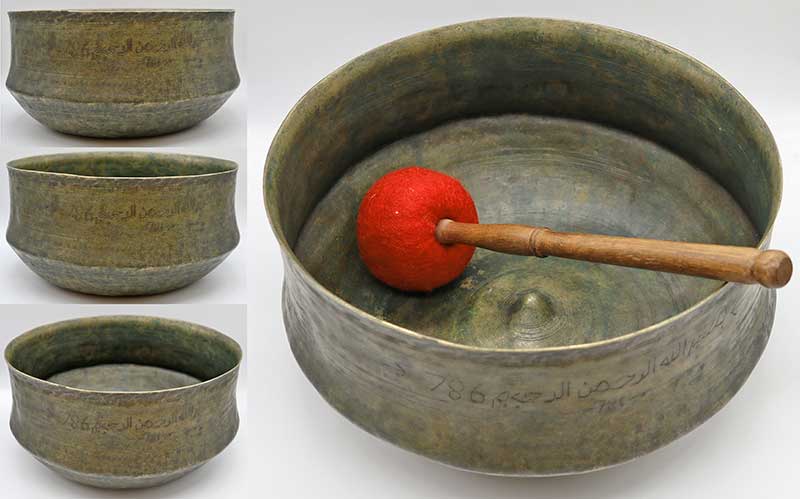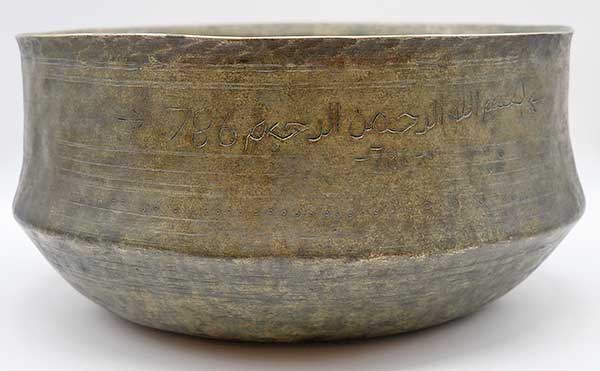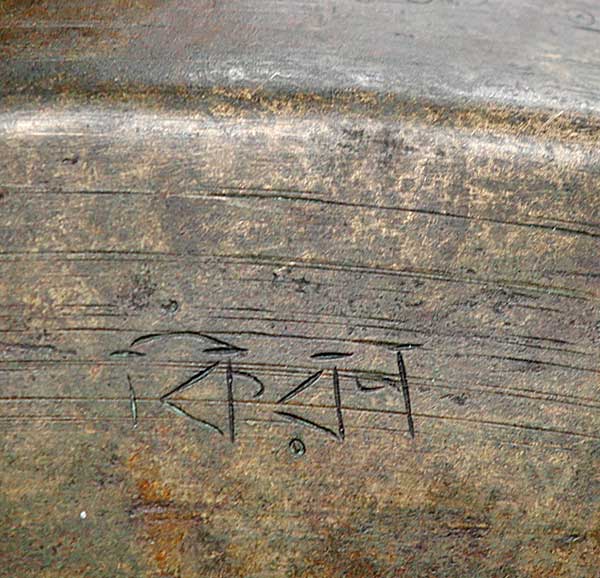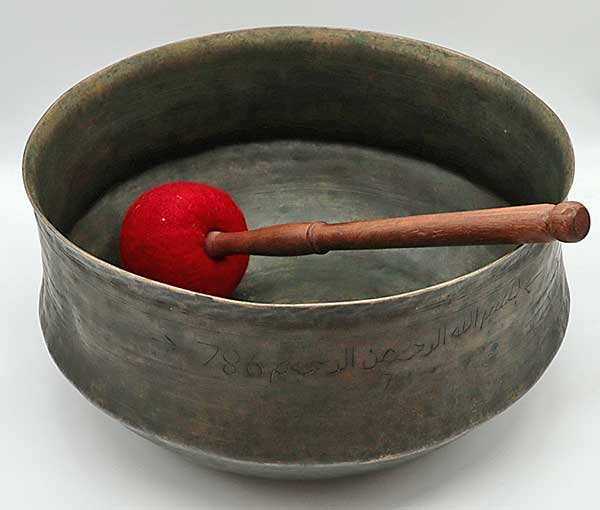Enormous Unique Multi-Faith Ceremonial G2 Antique Lingam Singing Bowl – 2 Inscriptions
£8,750.00
In stock
Antique Lingam Singing Bowl. Notes: G2/G#2 & C#4 (Throat & Root Chakras)
Weight: 3.96 kilos (8 lb 12 oz). Size: 31.5 x 16 cm (12 ½ x 6 ¼ inches)
This extraordinary Antique Lingam Singing Bowl (Circa 1800) is by far the rarest in my collection and, indeed, the most interesting. It has an utterly unique shape for a lingam bowl and is among the largest and heaviest I have encountered in over 40 years of collecting. It benefits from 2 inscriptions, one Muslim and one Hindu.
This multi-harmonic bowl is slightly self-amplifying and has a beautiful low second octave fundamental that hovers between G2 and G#2 (100Hz – 102Hz) when struck with a padded mallet. It is very close to concert pitch. The struck note is sometimes accompanied by a middle C#4 (273Hz) harmonic. It has lots of vibrant energy and a nice pulsating sustain. The rim note is a second octave G#2 (102Hz) when played with a heavy suede ringer and middle C#4 (273Hz) with a regular one. This ancient large singing bowl weighs almost 4 kilos and is best placed on a bowl cushion for playing.
It also benefits from 2 inscriptions, a fair indication of the high esteem in which at least two former keepers held this bowl. It’s impossible to determine which came first. The more significant inscription, in Arabic, is the opening phrase to the Holy Quran and reads ‘Bismillahir Rahmahir Raheem’, which translates to ‘In the name of Allah, the Most Gracious, the Most Merciful’. The inscription is accompanied by the number 786 (twice), the numeric value of the same holy phrase. Muslims in the Indian Subcontinent tend to use the number instead of the phrase. It is also considered lucky; many want 786 in their car no., mobile number, and house number. Some even collect bank notes bearing the number, which adds to their monetary value.
Interestingly, the smaller inscription is written in Bengali and bears the male name Kisan, a Hindu name of Indian or Bengali (Pakistani) origin. It is one of the many names of the Hindu God, Lord Krishna. In Hinduism, the number 786 relates to the Sacred OM.
Remarkably, it is apparent that during its lifetime, this bowl has been an important sacred vessel or instrument for two people or communities of entirely different faiths, Muslim and Hindu. The number 786 stands for Allah in Islam and the Holy word OM in Hinduism. The bowl was sourced in India.
The unique shape, size and weight of this bowl, its two inscriptions, and its sonic capabilities suggest that it served an important ceremonial or ritual purpose. It has a pronounced scooped shoulder, a plain sheered lip, and a flat bottom. The upper half of the wall is relatively fine, with most of its weight concentrated below the wall’s midpoint and its floor. The unusually large Lingam at its centre is surrounded by multiple circles that travel up the inner wall to the rim. These circles include a band of suns (dots inside circles representing the sun). There is a deep depression and matching navel or yoni beneath the Lingam. The outer wall, featuring the inscriptions, is decorated with multiple incised bands with groups of suns at intervals and a band of suns encircling the shoulder. Sun motifs are occasionally found in older bowls but rarely, if ever, in Lingams.
The structural condition of this beautiful ancient ceremonial bowl is excellent, and it is free of stains. Some of its decorative elements have worn down and are faint after centuries of use, for example some sun motifs have lost the circle surrounding the dot at its centre. There is faint evidence of a possible historic repair to a blemish on the lower inside wall, perhaps during or soon after its manufacture, but this is barely noticeable and does not detract from the bowl’s considerable aesthetic appeal or superb sonic qualities. It has a fabulous dark matt golden bronze colour with an aged patina and the look and feel of great antiquity.
This is undoubtedly an important and unique Antique Lingam Singing Bowl, and its new guardian will have one of the rarest and finest specimens in the world! It currently resides in my own sitting room, but its sale will help fund my humanitarian work in Nepal where I am attempting to raise the dire living conditions of a remote and marginalised village of 61 impoverished families (Pop 282). More information can be found on my Facebook wall https://www.facebook.com/fred.wilkinson.79
The price includes a large Tibetan silk brocade bowl cushion, a padded striker and two suede ringers.
NOTE: Antique Lingam Singing Bowls are sacred ritual and musical vessels and the rarest and most sought-after of all Himalayan bowls. They typically have diameters of between 5 and 7 inches (23 to 28 cm). Very occasionally one of 9 or even 10 inches will come to light, but anything larger is virtually unheard of! This fabulous museum quality specimen has an astonishing diameter of 12 ¼ inches!
NOTE: The price of this wonderful Antique Singing Bowl will be reduced to £7,000 with the discount code asb20%retire when checking out. It is one of my most prized possessions and is displayed in my own sitting room. This retirement discount is time limited.
In stock
Compare




